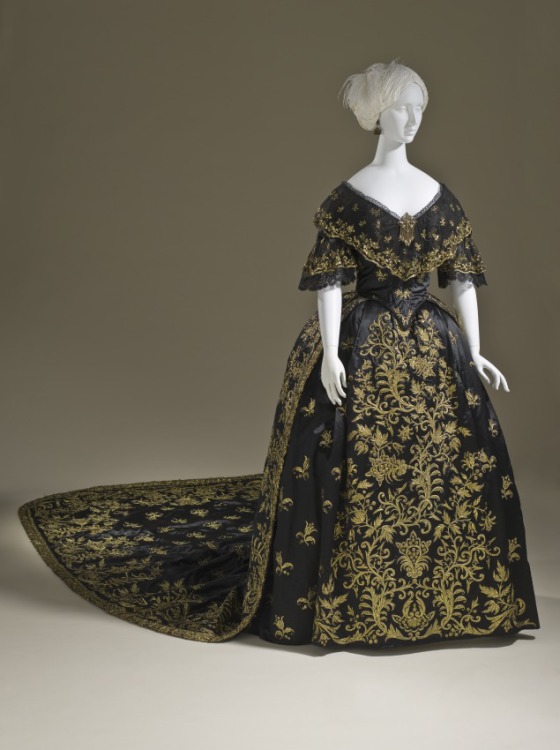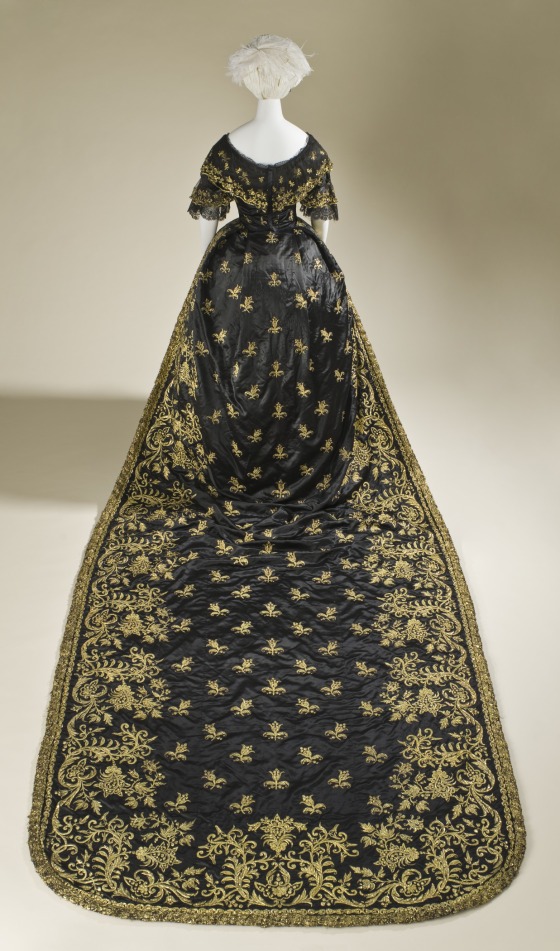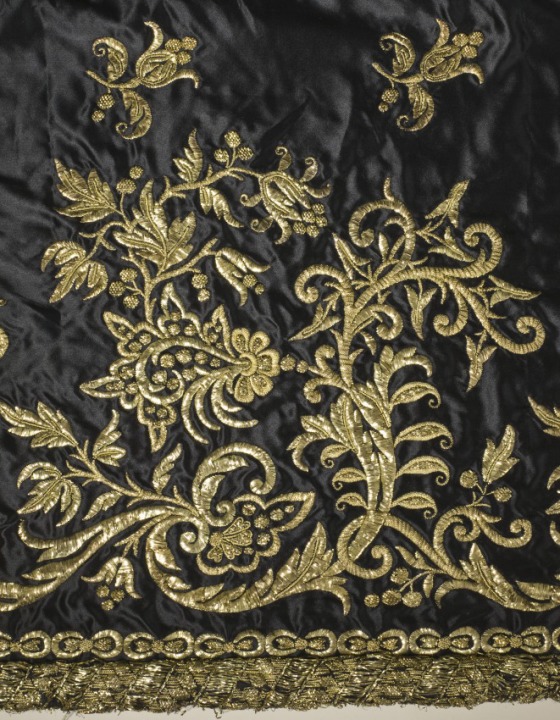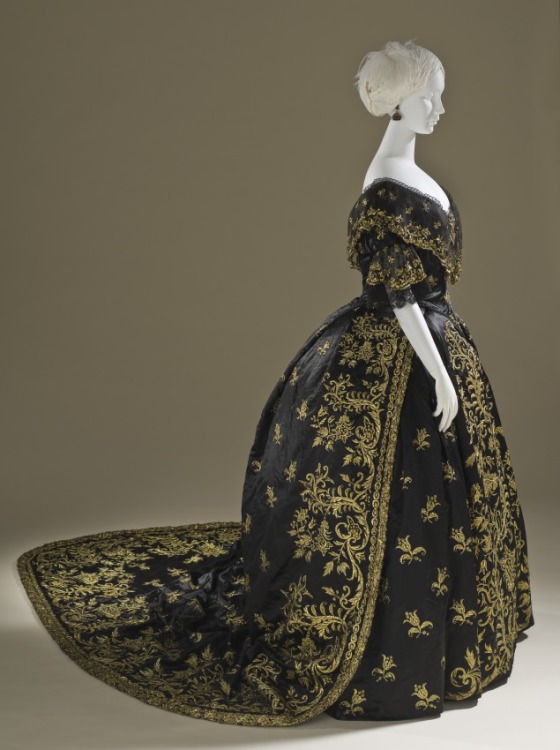Last week I showed Charles VI, Holy Roman Emperor in vivid yellow: a colour determined to make a lasting impact, for a man who aspired to the same. You agreed that the colour was quite a stand-out, but weren’t sure it did anything for the man wearing it. I haven’t tallied the points yet (running late again, I’m sorry!), but I’m sure they weren’t in Charles’ favour – he did, after all, get compared to ‘early Big Bird’.
Update: Charles actually did slightly better than I thought – 6.3 out of 10, for “Fantastic outfit, wrong wearer” as HoiLei succinctly put it.
This week I’ve picked another garment aiming to make a royal impression: a ca. 1845 Court Dress picked a very simple idea for impact, and stuck to it: elaborate gold embroidery on black.
This court dress is given a clear provenance to Portugal, and the assumption is that it was court dress worn at the Portuguese court.
In the 1840s Portugal was ruled by the relatively liberal and forward thinking Brazilian-born Maria II (her nickname was ‘The Educator’, which is bound to endear her to me), and her husband, Fernando II. Maria’s route to the throne was difficult and circuitous, but once she was established as Queen she had a fairly peaceful, prosperous and uneventful rule, and a happy marriage.
The rules around Portuguese court dress of the 1840s may have specified the black and gold colour scheme of this striking frock, though I cannot find any documentation to support this (granted, I spent a couple of hours researching on the internet, and there isn’t much information in English, so gave up). I also wasn’t able to find any major members of the Portuguese royal family who died around 1845, so the colour was probably not prompted by court mourning.
If the wearer of this dress was not constrained by the rules of national costume, or the rules of court mourning, than the dark colour scheme must have been her own choice: either because of personal mourning, or to show both wealth (black was still an expensive dye in the years prior to aniline dye) or to best showcase the gold embroidery.
Other than the striking colour scheme, the dress adheres to the conventions of formal court wear and evening attire universal across Europe in the 1840s: the low neckline helps to highlight the delicate skin of the bust and neck, the drooping ruffles of the bertha and sleeves emphasise the slope of the shoulders, and the full skirts and elaborate bodice trimmings serve to further create the illusion of a tiny waist.





Black as a fashion color did sometimes turn up already by this period; in any event, that volume of gold embroidery isn’t compatible with mourning.
Despite the ornateness of the embroidery, this gown is, in its way, elegant in its simplicity, and that kind of elegance strongly appeals to me. The only thing I don’t like about it is the train. In fact, I do not like the court requirement for trains in general, but because I know it is a requirement, I won’t penalize this dress for having one. A 10 from me.
“that volume of gold embroidery isn’t compatible with mourning.” There is certainly writing in the 18th and early 19th century about what women in mourning should wear to the English court, and it definitely includes a great deal of ornamentation and embroidery, and I’m pretty sure I read one 18th c one about gold embroidery (depending on the level of mourning), so I’m not sure that is true, though this is a bit later.
Leimomi: You may be right, though I’d thought that embroidery on a mourning gown that was not black, white, or another mourning color was forbidden. Even if gold embroidery was permissible in some contexts (and/or for some people such as kings or queens), that’s an awful lot of gold to qualify for mourning attire. I’d want to see some research to be convinced that this was meant to be a mourning gown. The easy way to address the issue would be to look into Maria’s life and see whether she would have been in mourning for someone at the time the dress was made and first worn.
And a 10 from me, as well.
Even given the constraints of photography and the age of the garment, it is a stunner, with the embroidery motifs beautifully disposed. I suspect that in its own milieu, lit by chandeliers, it would have been even more stunning.
Oh, a 10! It’s so beautiful. The colour scheme keeps it muted and even understated (which, I wouldn’t think heavy gold embroidery and a train would be) but in a room full or coloured dresses, to me, this would stick out as regal, serious, and dignified.
I usually do not care for dresses from this period; however, for this one I will make an exception. 10/10
The black and gold is very striking and not an unpleasant match. The amount of embroidery is amazing. I assume all of that embroidery would have been done by hand making this dress even more amazing. Very showy dress without being unconventional. 10/10
According to Fashioning Fashion, the urban legend says that this gown belonged Maria II herself who gave it to British officer as a gift. And it also says that its train lost quite a few inches when it was re-purposed for a costume party. But even with the shorter train, it’s still super-lavish, but not awkward.
I do like the strong contrast of the black and gold – and that whoever created this had the good sense to leave it at that. Here you don’t find brown velvet buttons or white lace inserts. It’s all very matchy-matchy – and it has to be. Add another element to this gown and it falls apart (figuratively speaking). But reducing everything (even the lace) as black background with gold embroidery, gives it a necessary but elegant simplicity. This is a gown that could be worn in all its splendour and yet would not overwhelm the wearer. 10/10
Wow, a 10 for me as well. I love the simplicity and the train though I wish it wasn’t squared off at the end. Still, it’s breathtaking!
It’s beautiful, and tasteful even though all that gold embroidery is very ostentatious. I’m not usually a fan of the court train, but this is a fine example. 10/10
where else to go but 10
It’s definitely doing court dress in all the right ways. The embroidery is perfectly proportioned – see how the motifs are slowly getting bigger from the collar down to the bottom of the skirt? Amazing. 10/10
Gorgeous dress in it’s classic color pairing of black and gold. It’s nice that the gold embroidery is lavish,as befits a court gown, yet not over the top gaudy. I suspect that the use of black is due to the rules of court dress. My guess is that the Portuguese royal court took the Spanish one as their basis for these rules and black was a commonly used color for the women, as well as the men, in Spain’s royal court.
10/10 for being such a delightful and lovely example of 1840’s court dress.
Classic and classy and beautifully balanced (with the possible exception of the train, but I guess when at court, do as the courtiers do). And thankfully the designer knew when to let well alone and didn’t add further elaborations to it, although I do enjoy the slight textural variation of the black lace at the bottom of the sleeves. 10/10 from me too.
Magnificently understated. One of the most elegant and tasteful dresses I’ve ever seen. 10/10!
I love the simplicity, while still being a gorgeous and striking pattern. 10 from me!
Yes!!!!! 10/10 especially with what R said about the train having been cut, because I can imagine a shaped hem for the train being spectacular, and I like to dream
It is spectacular. Really imposing and elegant and sumptuous, a dress with true presence – especially if considered alongside what we tend to associate with court dress (usually silver or cream or white, or super-colourful and sumptuous.) There’s something very impactful about soft, supple black satin with magnificent gold embroidery as its only embellishment, that would surely have made it stand out among other dresses, or harmonise gracefully alongside similar gowns.
This is a dress with real POW. It’s simultaneously sumptuous and subtle, elaborate and restrained, and looks almost ageless. Only the most boring, insipid wearer would end up being overwhelmed by this dress – anyone else would surely be showcased perfectly by it, and allowed to look at her best. A truly flattering black number that would give dignity and poise to the wearer, give a certain youthfulness to the mature wearer, or authority and presence to a young-ish wearer. I love this. Absolutely a 10/10.
Magnificent! 10/10
It’s gorgeous, not so keen on the bertha, but I know it’s something that was expected so I’m not going to take points off for that, it’s simply that I’m not a frilly person. I’d still wear it though, given half a chance!
10/10
That dress front to back, top to bottom, FABULOUS!
10/10
Oh dear, I’m going to spoil the party and the perfect 10. I love this dress. The words “restrained” and “court dress” don’t often fit well together but here they’re perfectly partnered. It’s elegant, the black and gold together are beautiful and the embroidery is exquisite. The front and back views are lovely ….. but, but, but …… for me it’s the side view that loses it that precious extra point and brings my score down to a 9/10. “Bulbous” is the only word I can think of to describe it and it’s not a particularly pretty or flattering one. Sorry.
That may be the fault of poor presentation on the part of the museum. 🙂 Combining a full skirt and a court train is rather awkward though.
Am I really the only one who doesn’t love it?
I acknowledge its well-thought out design… For instance, putting gold on black makes black a little more gentle on people with gold tones in their skin (black is such a hard color to wear). The embroidery is excellent, the restraint in color scheme is wise, and the whole thing is cohesive with little to quibble at.
The bertha and the train are an odd mismatch to my mind, because berthas look meek and trains look dignified. Plus the train looks so heavy and the neckline so low that I fear she might walk right out of the gown! But I approve the use of heavy satin for gravitas. It must have felt so sumptuous to wear.
Nevertheless, it’s a splendid example of something I don’t like. I don’t like black, and I don’t like that silhouette. I give it points for being wonderfully done on every front, but I withhold the perfect score because I just don’t like it.
9/10 from me.
10/10 Elegant, mature and just about perfect!
I love love LOVE the comments on this post! What an interesting dress. I like the 1840s in general, but try to rate a dress in context, anyway, with “try” being the operative word. I have imaginings that the wearer would be raven-haired, as many are in Portugal, and the dress would set off her tone, nicely. I find the dress shape balanced, and in fact, it reminds me of a black version of Princess Masako’s wedding dress.
10/10 for me, too!
Interestingly, Maria II had blonde hair that darkened to light brown – She looks very similar to Queen Victoria in colouring in paintings, and photos also show her with quite fair hair (though colours can show oddly in early photographs). Her mother was Austrian and had blue eyes, so she inherited that Germanic colouring.
Really? Well, I suppose the gold would set off the gold in hair. Makes the choice of dress more interesting, though.
10/10 Love it.
It is beautiful, a perfect match of embroidery and fabric. I don’t really like 1840s silhouettes, but frankly, one focuses on the embroidery and striking gold and black anyway. 10/10
I’m Portuguese, and a lover of the mid-19th century. How could this be anything other than a 10 for me? Now, how do I get a copy to magically appear in my wardrobe…?
The shaping of the bertha and sleeves makes it look very heavy, and there’s something inescapably carpet-like about that train. There’s also a thorough stiffness to it, but maybe that’s fitting for a court dress.
But I do really like it – black and gold and a big bell-shaped skirt! Those basic elements are so appealing – I’d love to see a modern interpretation of this gown. As it is, I don’t event mind that it’s from a period I usually have trouble liking.
8/10
The good things have already been said – Daniel did the dress proud. So, I love it, and give it yet another 10 out of 10.
I think it’s beautiful, regal, restrained yet appropriately ornate, etc.- the only thing I dislike are the proportions- I agree that the Bertha might be just a tad heavy. Could it have sagged with age? I might like it better if it were frothier and bouncier to offset the rest of the frock.
9/10
I’m impressed by how well the black has held over the years. It has been seriously looked after.
I’m not scoring it as I just don’t know how I feel about it. Except loving the embroidery big time!
The train is crazy long but I love it! It’s a 10!